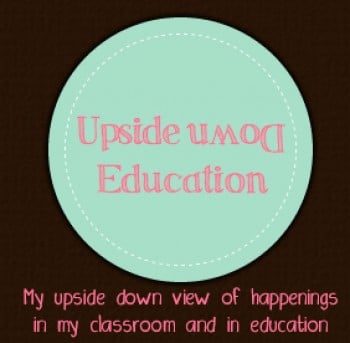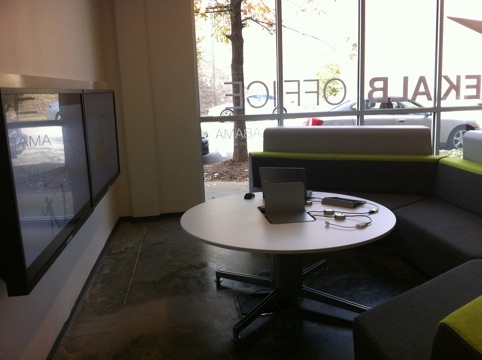So often we get on the soap box about “no desk in rows” or “no sage on stage” when talking about classrooms. Yet our classrooms are mostly supplied with 2 things: desks and boards in the front of the room. Maybe we get a table or chair or two but that is it. Then we are left to move these around as we see fit, but usually the best fit of all the furniture is rows of desks. Designers of schools are not educators and furniture salespeople aren’t either. Collaboration is not anywhere in the minds of there people. Their school experience was probably desk and chalkboard so why would they think differently? Last week I was able to visit an Education Environment Symposium at Dekalb Office. Dekalb sells school furniture and I really went in there expecting to see “desks.” But I was wrong!
Ed Roy who works for a company called Steelcase that makes furniture was the first to present. He immediately began to discuss pedagogy, learning, and teaching styles. I was actually shocked to hear this. His world revolved around furniture and his presentation kept going back to importance of collaboration in a classroom. He spoke about flipped classrooms, backchanneling, and learning from each other. He kept saying that classes that are completely based on just lectures were not meeting needs of all students. This presentation focused mostly on things we as educators focus on often. Sometimes on twitter it seems we almost beat these ideas into the ground. But it did not take me long to realize I was the only one from the K-12 area in the presentation. The others were from area Higher-Ed institutions (non edu depts), designers, or architects, people who probably don’t hear this everyday. Not only do they not here it, they never really even thought about it.
He had some great ideas about how the learning environments will change the dynamics of the classroom as well as the school. Some spaces he shared were:
- lecturer is set up in center of the room with all walls having screens, the view of projectors can be seen at any angle.
- classrooms have hubs set up through the room where students can project from one laptop but also have numerous white boards (the marker kind!) for brainstorming and collaboration.
- lecture halls that were surrounded by spaces for breakout rooms
- lecture halls where the tables can immediately be turned into areas for collaboration
- spaces for outside a classroom where students can sit on couches, can plug in computers/iPads and project them onto TVs (see picture)
- school buildings where the entrance is full of collaboration spaces and professors have to walk through the spaces to offices and lecture halls
I left there with a great understanding of how these collaboration spaces can change learning and which spaces are more effective. Also I loved how most of these spaces still allowed for whole group learning with projection around the classroom and desks or tables that quickly moved. I sat there mostly daydreaming of how wonderful these spaces would be in my classroom or if I ever was in charge of a school. (you are more than welcome to buy and donate any of these products to my classroom!)


This is great. I’m currently reimagining our school’s Innovation Center and looking at different furniture and how it affects things. Thanks!
I dream of a day when I’ll be allowed to take the round tables out of storage at school and trade the “desks” in my classroom for them!
Angela,
Don’t despair it can be easy to facilitate the kind of change you are seeking in your class with the tools you already have. Check out my presentation from earlier in the year. http://www.slideshare.net/mobile/dakinane/2011-ewrapper-conference5thwall. You might also want to take a look at David Jakes’ presentation on slideshare.net ( I reference it in my presentation) it is called “would you want to learn here”. In it David illustrates the psychology of furniture in learning spaces. It is inspirational.
Great post and agree with what you are saying here. You MIT also want to read whT I have said on the subject on my blog in the past http://dakinane.com/blog/2011/02/27/interface-article-issue-29/
Keep up the good work.
It is good to know someone is designing to help promote authentic learning! I have been thinking a lot about classroom design and how to present the need and expense for something other than desks. Thank you for adding to my growing collection of resources!
Pingback: » Blog Archive » Elearning pedagogy and furniture
Timing is perfect for us… I am passionate for creating innovative spaces for learning at our school. I think the ‘environment’ is like our second ‘hidden’ curriculum in our classrooms. We are currently adding 28000 square feet to our campus and we are planning on creating such spaces as shard above. Just yesterday I took our design team to look at Steelcase show room here in Calgary, AB. As a colleague of nine once said, if there is any building that reflects innovation and creativity, it should be a building that houses children!
Keep dreaming and believing for the limitless possibilities
Derrick
Thank you, Angela!
This post is inspiring and useful. I’m at the end of my first year of teaching high school maths in South Africa and am in the process of re-imagining my teaching space for next year.
What I found particularly helpful was the fact that not all of the points you made required a huge number of resources and money (which is horribly scarce in our education system). This made it possible for me to dream big while not entirely leaving the realm of the possible.
I have a few questions, though perhaps they don’t have answers. How do you manage the shift between individual and collaborative work and the vastly different spaces required for each? Is individual work still valuable in a collaborative age? If not, how do we cope with a system which requires examination success?
Please keep writing!
Joanna